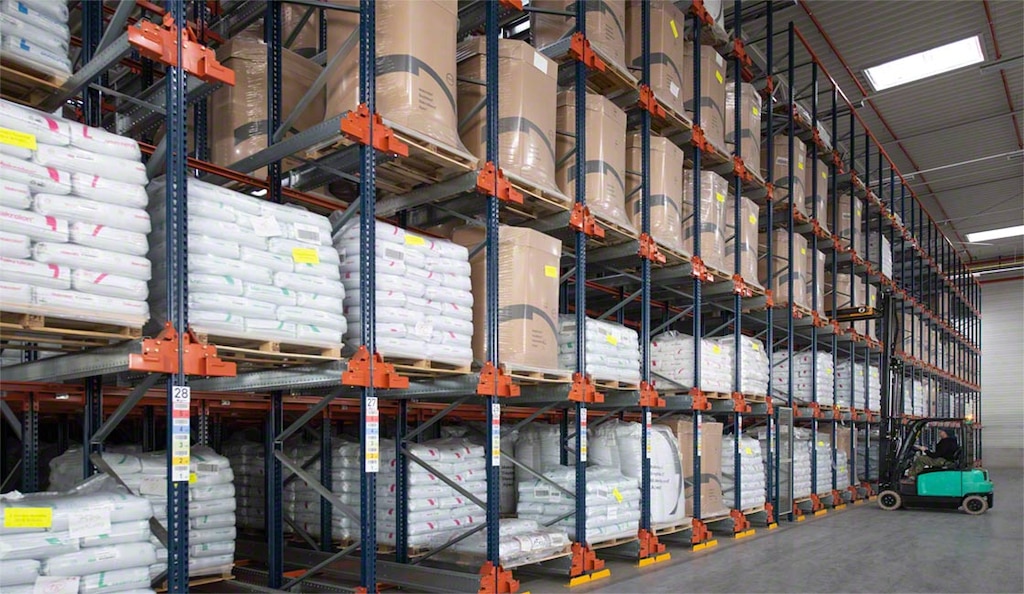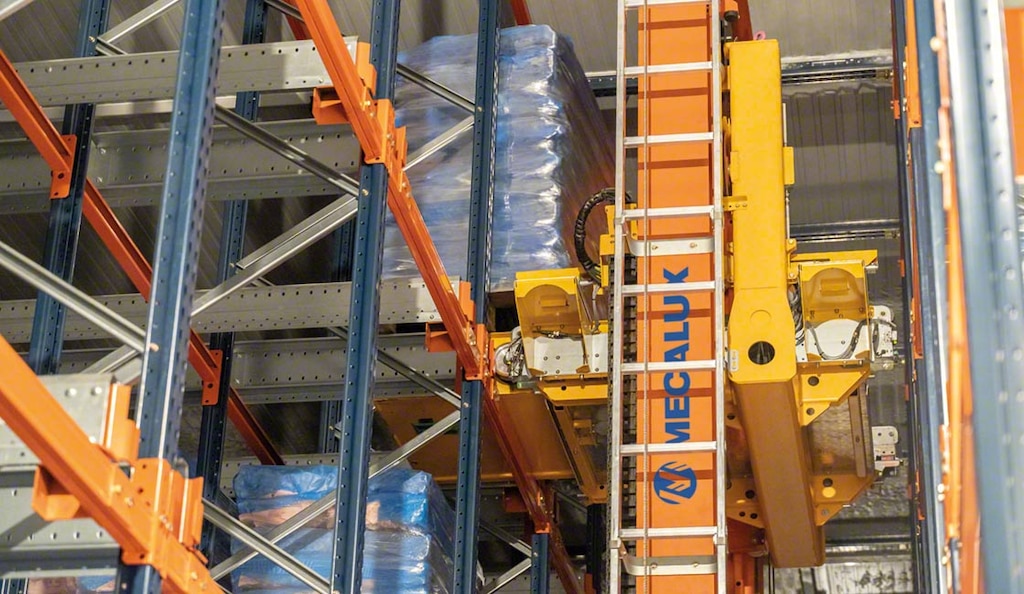
Which to choose: the semi-automated or automated Pallet Shuttle?
How can you choose between a semi-automated and an automated Pallet Shuttle system? Logistics managers faced with this dilemma already know that the Pallet Shuttle is the best solution for their warehouse. The real question is whether they should opt for the semi-automated system, served by forklifts, or for the automated version, supported by stacker cranes.
However, before doing a deep dive into the comparison between the two, let’s briefly explain what a Pallet Shuttle is. It’s a solution that reduces the space occupied by goods in a warehouse by eliminating aisles. This compact storage system is based on a motorized shuttle (Pallet Shuttle), which is inserted into the racks to deposit or remove pallets from inside them.
The Pallet Shuttle could be considered an evolution of drive-in drive-thru pallet racks. But instead of a forklift entering the aisle, the Pallet Shuttle performs this maneuver. This improves operator safety as well as the ability to store the goods compactly and house a greater variety of SKUs in the same space.
The difference lies in how the Pallet Shuttle arrives at the racking. With the semi-automated system, an operator has to transport the shuttle with their forklift and then control its movements. With the automated system, there is no human intervention at any time during the process.
What’s a semi-automated Pallet Shuttle?
The semi-automated Pallet Shuttle comprises an electric shuttle and a set of high-density racks. Using a forklift, an operator places the shuttle at the input end of the channel where work is to be done. Once the shuttle is positioned in the racking, the operator guides it using a Wi-Fi-connected tablet. By means of an onboard programmable logic controller (PLC) and a Wi-Fi antenna, the shuttle receives instructions from the higher-level software and executes the programmed movements. The shuttle raises the pallet to deposit it in the first available location, repeating this operation until the channel is full.
The Pallet Shuttle, in both its semi-automated and automated versions, is the perfect tool for increasing productivity in manually run warehouses, especially when working in adverse environmental conditions (it can operate in freezer stores in temperatures as low as -22 °F).
The electric shuttle compacts the goods, which comes in handy when handling a high volume of pallets per SKU. This is the case of the warehouse of German industrial services company WISAG, which has two blocks of 31-foot-tall high-density racks. The motorized shuttles streamline operations in this storage system, which provides capacity for 11,000 pallets.

With the Pallet Shuttle system, goods tend to be managed according to the LIFO (last in, first out) method, where the last product entered is the first to leave. This goods retrieval system is extremely effective for products that don’t have an expiration date. Nevertheless, the racks can also be set up in line with the FIFO (first in, first out) method, as long as the racking bays have an entrance and an exit on either side.
As with any storage solution, in a manually operated warehouse with high-density racking, the safety of the system, of the goods, and, especially, of the operator is a key concern. The semi-automated Pallet Shuttle system features multiple safety components on the shuttle itself and on the racks: shuttle stops, end-of-track sensors, and a safety bumper on the shuttle, and rail stops on the racking.
What’s an automated Pallet Shuttle?
The automated Pallet Shuttle (APS) also consists of a shuttle and compact racks. But this storage solution replaces forklifts with automated handling equipment such as transfer cars and twin-mast stacker cranes, which move the shuttle in the various storage channels in the racking.
The APS stands out as a fully automated solution. The shuttle is guided by warehouse management software, which coordinates all operations, optimizing the movements of both the shuttle and the stacker crane. Automated equipment can perform combined work cycles, storing goods inside the channel and removing the required load in the same movement.
This solution is effective for businesses that have high order density warehouses with a large number of pallets per SKU. In addition, in facilities with high product turnover, this system ensures constant inflows and outflows of goods and, most notably, minimizes the risk of error in tricky operations such as pallet storage and removal.
Just like transfer cars, twin-mast stacker cranes — which hold the shuttle in their cradles — constitute handling equipment capable of withstanding and operating in harsh environmental conditions, e.g., in cold stores. In fact, this is where they shine: operators’ productivity is limited because they can’t be constantly exposed to the cold, but these machines generate the same throughput 24/7.
A case in point is the fully automated warehouse of Cárnicas Chamberí in Toledo, Spain. In this facility, which runs at a controlled temperature of -4 °F, an automated Pallet Shuttle streamlines the storage and retrieval of pallets in a block of high-density racks. “To speed up the distribution and delivery of our customers’ orders, we knew we had to get better organized and run fully automated logistics operations,” says Juan Carlos Camacho Hernández, CFO at Cárnicas Chamberí.

Which system should you choose: semi-automated or automated?
The Pallet Shuttle system is very common in warehouses with a large number of products per SKU. In fact, both the semi-automated and automated versions are advantageous in cold storage facilities, as they store the goods in a compact way, leverage the capacity of the building, and lower energy costs.
The choice of a semi-automated or a 100% automated Pallet Shuttle system will depend on multiple factors, namely:
- Workflows: the volume of product demand and SKU turnover will determine whether you should install an automated solution to increase Pallet Shuttle work cycles.
- Investment: the degree of initial investment is contingent on the needs of each company, its warehouses, and the type of product handled. Equipping a facility with the semi-automated Pallet Shuttle system requires a lower outlay compared to a fully automated solution.
- Warehouse capacity: the amount of square footage allocated to storage is a crucial variable. That is, automated solutions operate in narrower aisles than those required by forklifts. Likewise, automated storage and retrieval systems (AS/RS) guarantee agile and safe handling at great heights.
- Safety: operators mustn’t be exposed to unfavorable environmental conditions for long periods of time. Aside from being detrimental to their health, their productivity decreases in these environments. Swapping forklifts for transfer cars or stacker cranes that automate the Pallet Shuttle’s movements makes it possible for these warehouses to work at peak performance.
- Ineffective operations: when the facility can’t even dispatch orders at maximum throughput in three work shifts, it’s essential to implement technological solutions to ramp up productivity.
- Logistics marketing: warehouse automation can enhance a company’s prestige, as this entails faster, safer operations while promoting logistics attributes such as product traceability.
In the end, both the semi-automated and the automated Pallet Shuttle optimize the movements of manual systems and, most importantly, minimize the possibility of errors in goods handling.
Top throughput for your warehouse
In its semi-automated version or combined with stacker cranes and transfer cars, the Pallet Shuttle is an ideal logistics tool for optimizing the storage capacity of a logistics facility and for accelerating the operations taking place in it.
At Interlake Mecalux, we have extensive experience in designing and implementing automated and semi-automated shuttle systems. Be sure to get in touch. An expert consultant will study your case to come up with the best solution for your needs.
